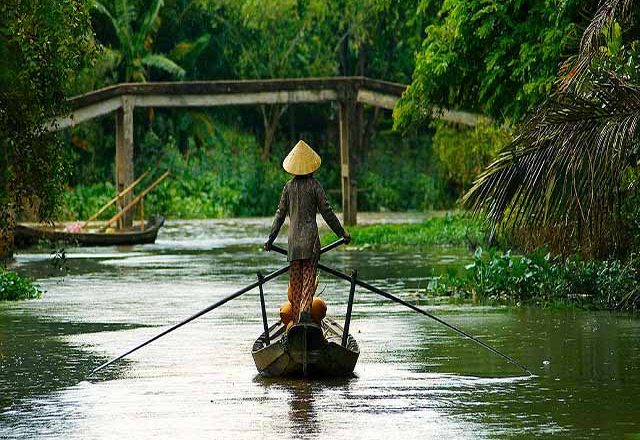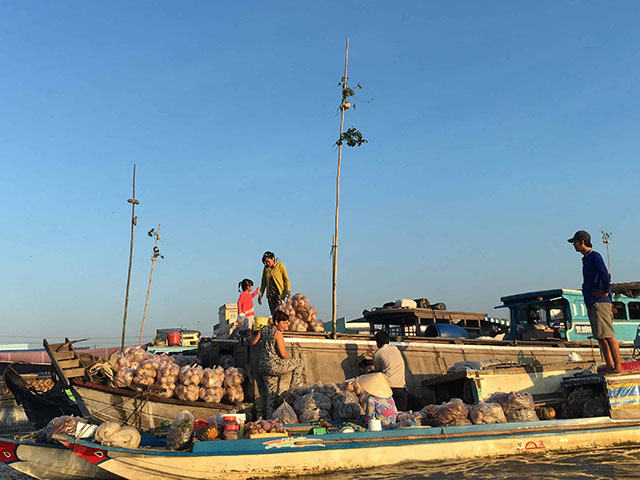Mekong Delta or ‘Mien Tay’ – the endearing name Vietnamese people often call the land – has always been the most unique destination of Vietnam. With most of the land covered and divided by wetlands and rivers, Mekong Delta has developed a unique way of life and culture adapting to the geography characteristics. There’re a lot of things to do in Mekong Delta Vietnam – the region that includes 13 provinces/cities with the immense beauties and cultural charms. Do explore them with Hue to Hoi An Jeep Tour.
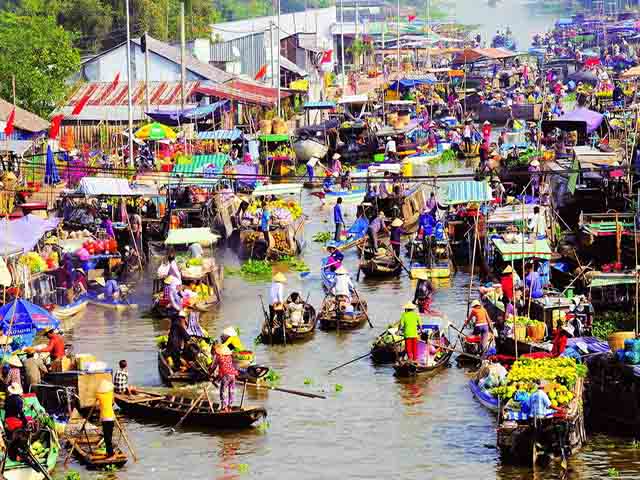
WHERE IS MEKONG DELTA
Mekong Delta lies at the very end of Vietnam, right under the southern central city of Vietnam, Ho Chi Minh City. The region is consisted of 12 provinces (Long An, Tien Giang, Ben Tre, Vinh Long, Tra Vinh, Hau Giang, Soc Trang, Dong Thap, An Giang, Kien Giang, Bac Lieu, Ca Mau) and one city Can Tho.
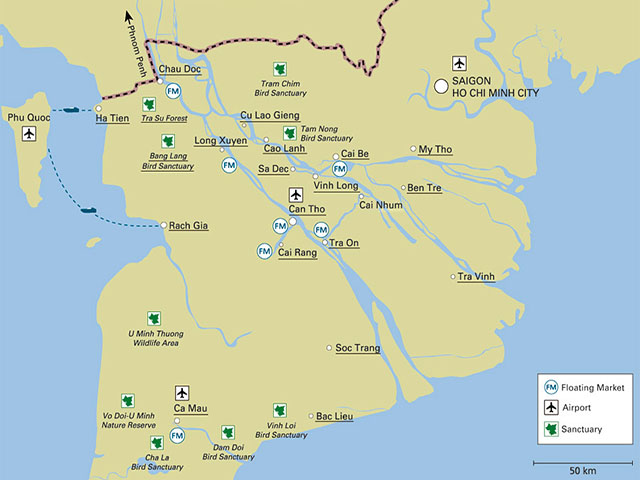
Mekong River
Mekong is grand, fertile and primitive. Starts at Tibet, the river runs 3,000 miles through China, Myanmar, Laos, Thailand and Cambodia before entering Vietnam’s delta and out to the East Sea. Vietnamese call it “Song Cuu Long” which means “9 dragons” symbolizing the nine branches that created a vast delta region of 12 provinces and one city of the south. During thousands of years, this river has fed 60 millions of people on its way, enriched various regions and countries, fostered the culture diverse of Southeast Asia in general and Indochina in particular. There is no wonder why people call the river “Mother of Water”.
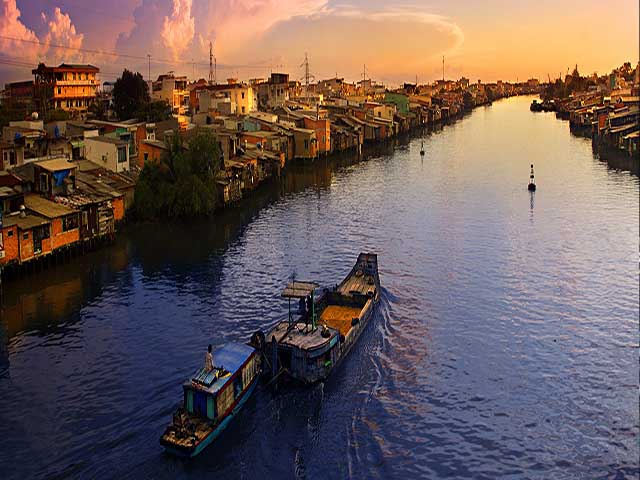
The Mekong river enters into Vietnam through Cambodia with two separate branches which are “Song Tien” and “Song Hau” (Bassac River). Both run through the delta and have same length about 200-250km.
THINGS TO DO IN MEKONG DELTA
Mekong Delta is a large region with a lot of sites to check out and it’s understandable if you feel a bit overwhelmed. We list here all the must-have things to do and see in Mekong Delta for a trip under 9 days.
Visit floating markets to enjoy the daily life on Mekong River
The most unique and peculiar thing about Mekong Delta is no other than floating markets where you can see all the way of life, daily activities and culture of the people here. Floating markets are not a specialty that can only be found in Mekong Delta. Thailand also has many floating markets. Yet, Mekong Delta’s floating markets have their very own different charms. These markets has been existing just simply for local farmers to sell fruits and vegetables to the folks on the land.
– Cai Rang Floating Market – Can Tho
Cai Rang Floating Market is the most famous and also the most touristy floating market in Vietnam. You can visit Cai Rang Floating Market easily once arrived in Can Tho city. However, don’t forget to set your alarm earlier to catch the market that starts at 5:00AM every day. Rent a boat from Ninh Kieu pier which will take you to the market in 30 minutes.

Cai Rang is a wholesale local market where farmers will hang their what they offer on a tall stick to let the buyers know. Some fruits of the land can be named as Nam Roi grapefruit, Vinh Long pink kiwi kumquat or Cai Mon durian. Visitors to Cai Rang market not only can watch the early activities of the locals but also can have breakfast right on the boat, dishes are mostly southern own noodle soups. Other snacks are also available like coconut-leaf-cake or corn or banana pancake.
– Nga Bay/Phung Hiep Floating Market
Nga Bay or Phung Hiep Floating Market has been around since 1915 as a key trading spot for the locals in Nga Bay Town. This floating market is the most vivid and colorful markets in all Mekong Delta region. A perfect floating market if you don’t like the touristy Cai Rang Market.

Just like any other market, Nga Bay also starts very early in the morning every day. Fruits, vegetables and other household goods all stack up on the sellers’ boats, making it a wonderful sight to behold. This market is also the place where animals like turtles, birds and lizards.
You can get there by bus or taxi to get to Nga Bay province which is about 30km away from the city. Boat rental is available but it’s best to do it with a group to reduce the average cost.
– Cai Be Floating Market – Tien Giang
At Cai Be District, there’s a floating market that caters transporting goods, fruits, veggies and even seafood to not only Mekong Delta region but also to the rest of Vietnam. Cai Be is a perfect choice if you don’t have much time to discover the whole delta since its location is quite close to Ho Chi Minh City. To visit Cai Be Floating Market, you don’t have to wake up too early like the other markets since the market opens until later hours of day.
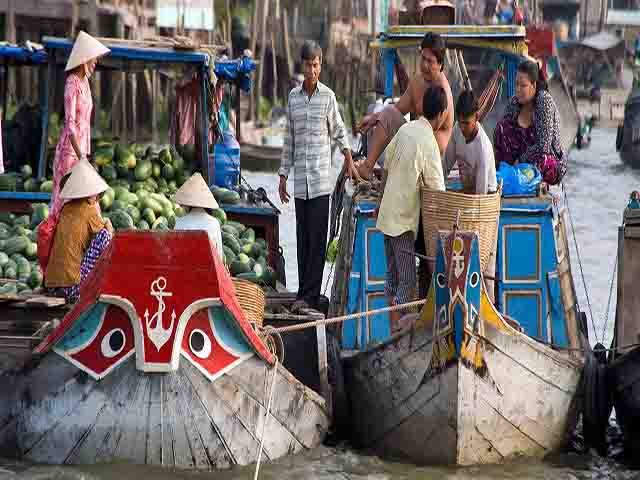
Cai Be province is located 80km away from HCMC through 1A highway. You can there by booking a private tour or getting a taxi. Once you’re in the province, ask the local people for directions to the market.
Boat rental is available for a 2-hour tour with tour guide costing $2/person. Private boat for group of 10 at cost $25/boat.
– Nga Nam Floating Market – Soc Trang
Nga Nam Floating Market is the junction of five rivers – Ca Mau, Vinh Quoi, Long My, Thanh Tri and Phung Hiep. And for its special location, Nga Nam market is bustling with all the colors and the sounds of the locals. This floating market is very much untouched by the tourism and still remains the unique characteristics of a Mekong Delta floating market.
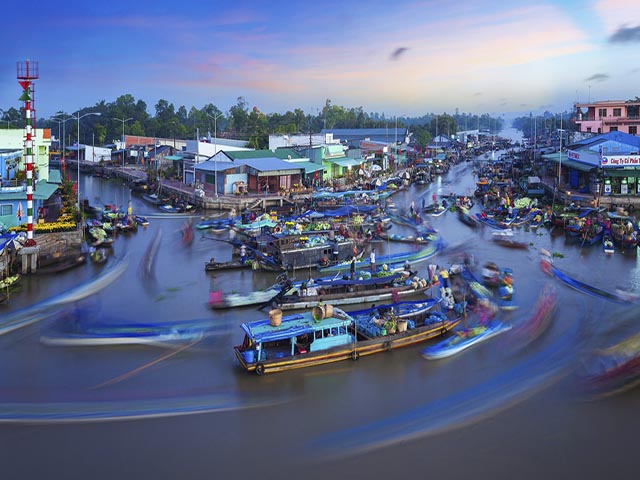
Come to Nga Nam floating market, you’ll countless of boats selling local goods like vegetables, fruits, seafood and more. Each boat has a tall bamboo stick hanging what types of goods available.
Nga Nam market starts at 3:00AM, become busiest at 5:00AM and dismisses at 8:00AM. Buses are available to Ca Mau, Nga Nam market, costing about $8-$9 for one-way ticket.
Boat rental is available for cost at $1/person and you can visit the whole market.
* Fun facts about the floating markets:
There is only one rule used in all floating markets of Mekong Delta – the sellers will hang the things they sell on a stick to let the buyers know exactly what the merchant is selling.
Yet there’re still some exceptions:
Things that are hung but not for sale: a large number of residence in Mekong Delta live on a boat so they might hang their clothes for drying which can sometimes be mistaken for merchandise.
Things that are for sale but not hung: mostly foods and drinks which are very difficult to hang up a stick.
Hang one but sell another: when traders hang coconut leaf on the lateral bar, it says that they want to sell the boat.
Discover Tan Chau Silk Village – An Giang
You don’t have to go all the way to Hoi An for quality silk. In Mekong Delta, there’s a village that has been around for a long time and made its name for natural silk material. Come to Tan Chau Silk Village to see the process the traditional silk making.
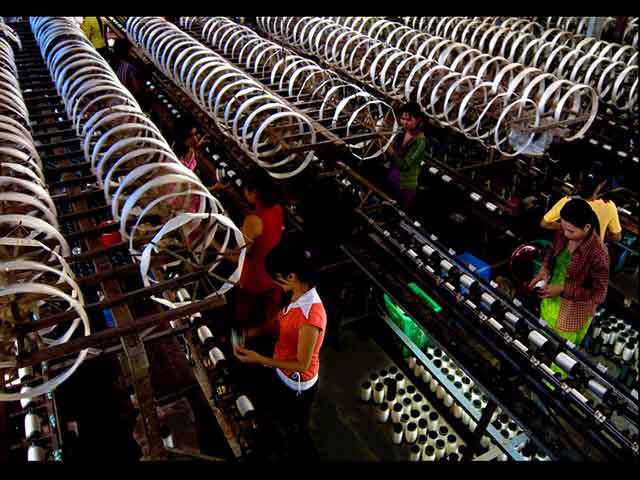
Tan Chau silk is known for the softness, toughness and high absorbability. Tan Chau Silk Village is not to be missed in your trip in Mekong Delta.
Discover Tra Su Cajuput Forest – An Giang
If you’re curious about what the wetlands of Mekong Delta look like, come to Tra Su Cajuput Forest – an ecotourism site turning green by the water ferns during the rainy season every year. The whole forest is flooded with green water, making an incredible sight especially when the sunlight reaches down the water surface.
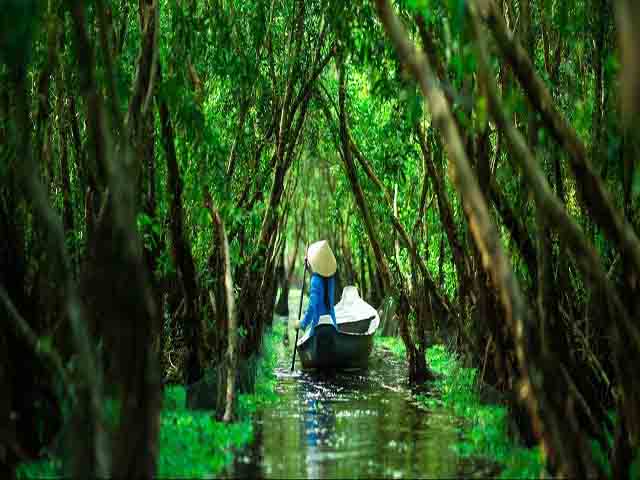
The forest is also the habitat for many colonies of water birds, bats and even rare and endangered animals and reptile species.
The only way to visit Tra Su forest is going by boat, paddled and guided by the local ladies. Entrance ticket costs 130,000VND per person. Best time to visit is of course the rainy season from September to November.
Taste freshness of fruits in Cai Be Fruit Orchard – Tien Giang
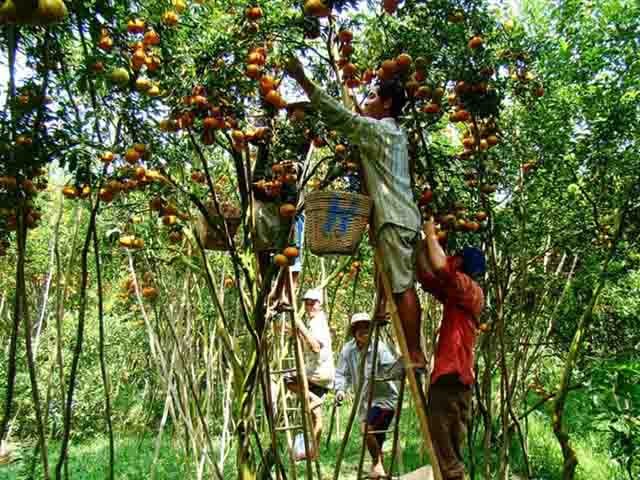
Since Mekong Delta provides two-third of the fruit consumed throughout Vietnam, tasting the fruits should be while in Mekong Delta. The perfect places for that are the fruit orchards which can be found in most of the region. Cai Be Fruit Orchard is the largest fruit orchard in the delta, offers the tastiness of all kinds of tropical fruits. During your visit to the orchard, you can pick up the ripe fruit right off the trees and enjoy them.
Bird Watching at Tram Chim National Park – Dong Thap
Tram Chim National Park is another kingdom of birds in Mekong Delta, located at Dong Thap province and can be easily reached by motorbike or car. Spanning over the total area of 7,500 hectares, Tram Chim National Park is home to 200 types of birds, of which many are rare and endangered. This number makes up a quarter of the bird population in Vietnam. Tram Chim Park is also the place you can see a large number of the rare white lotus in Vietnam.

To go bird watching, you’ll have to book a boat tour that costs 800,000VND per boat for a group of 12 people. The tour lasts between 30 minutes to 1 hour or more.
Sampan Cruise in My Tho
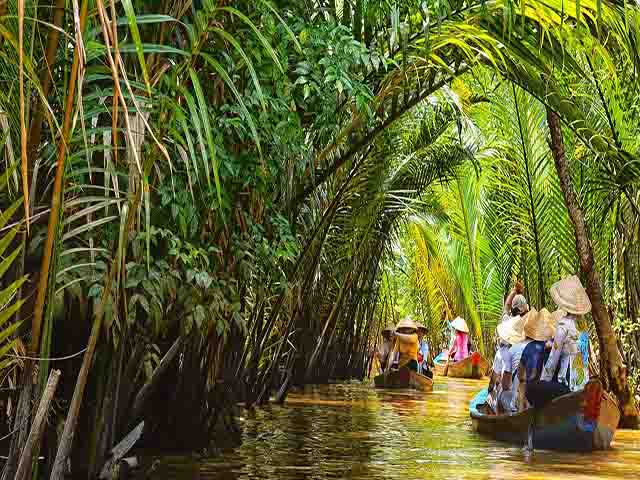
My Tho is just two hours from Saigon so it’s perfect for a sampan cruise from the city. Regardless where you start the tour, the boat will take visitors to Dragon (Con Tan Long), Tortoise (Con Quy) and Unicorn (Con Thoi Son) islands. The first stop is local fruit orchards for visitors to taste the fruits like jackfruit, pomelo, guava, with perhaps some local drinks like tea. A short sampan boat ride through the thick leaves of coconut trees. You’ll visit a candy factory where candies made of coconut milk are too cheap and tempting to not buy. Lunch is also included in the sampan cruise to My Tho to it may be varied.
Visit the Temples in Mekong Delta Vietnam
– Vinh Trang Temple, My Tho
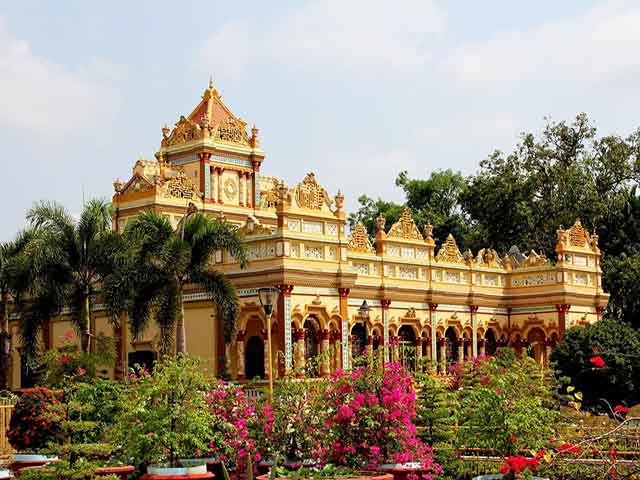
Vinh Trang temple is a very special temple in the whole region of Mekong Delta, covering an area of 2000sqm, adorned with the greenness of the trees and colors of the flowers. Built in 1849 in My Phong village, Vinh Trang is an excellent combination of European and Asian architecture styles. The splendid façade of the temple will give an impressive on you immediately. With five buildings, two ornamental yards, 178 pillars and two triumphal arches, Vinh Trang is a representative of the Buddhist temples in southern Vietnam.
You can walk to the temple if you’re staying in My Tho.
Bat Pagoda (Mahatup Pagoda)
Lying 25km southeast of Soc Trang downtown, Bat Pagoda is always included as one of the worthiest destination to visit in Mekong Delta due to its enthralling Khmer architecture features. The name of the pagoda will make you wonder if you can find any bat in the pagoda. In fact, the answer is yes: a large number of bats have been inhabited on the branches of the ancient trees in the yard of the pagoda. This is such an interesting feature that makes Bat Pagoda a must-see site during your trip in Mekong Delta.
MEKONG DELTA TOUR – RIVER CRUISES
Unlike Halong Bay cruises, Mekong cruises are known for the class and style just in recent years. The diversity in tour types and activities can compare to those of Halong Bay cruises, yet the cruises on Mekong River attract with its peculiar charms of the scenery and the way of life along the river.
Cruises’ Amenities
The cruise ships on Mekong vary greatly on style, type and equipment.
– Daily cruise tours: imagine a huge restaurant placed on a ship like La Perle de l’ Orient cruise ship of Indochina Junk can offer capacity for up to 200 guests and doesn’t have private cabins.
– Short trip cruises: Panorama Cruise of Mekong Eyes Cruise 2 Days is the perfect example – affordable and still maintain a level of luxury. While Le Cochinchine cruise ranges in the middle tier with much more comfortable private cabins.
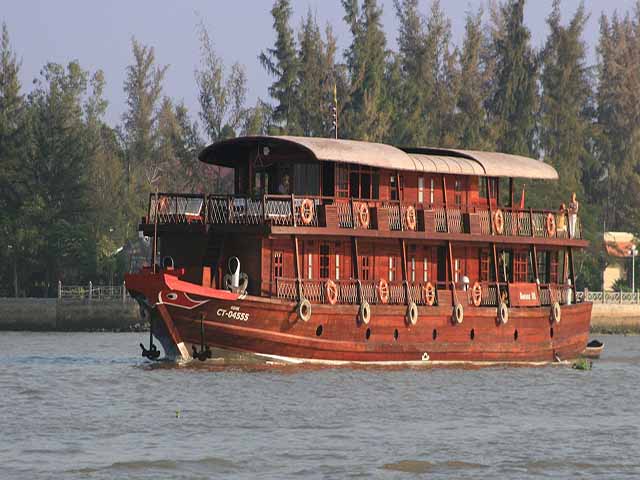
– Luxury cruise ships: they impress with their outstanding design of French colonial steamers. Jayavarman and The Jahan are just the masterpieces of luxury Mekong cruises.
Cruise Itinerary:
Mekong river cruising tours are available from one day tour to 2-3 days, 4-5days and even up to 8-10 days, from exploring Mekong delta only to the upstream in Cambodia, from cruising only to combining with land tours.
Tours within the delta will sail on the Tien river (the upper branch of Mekong river) featuring sites such as My Tho, Cai Be, Vinh Long, Sa Dec, Cao Lanh, Long Xuyen, Tan Chau. The expeditions expanded into Cambodia’s land include major stops like Phnom Penh, Kampong Cham, Kampong Chhnang, Tonie Lake and Siem Reap.
WHAT TO EAT IN MEKONG DELTA
Duong Dua (Coconut Larvae)
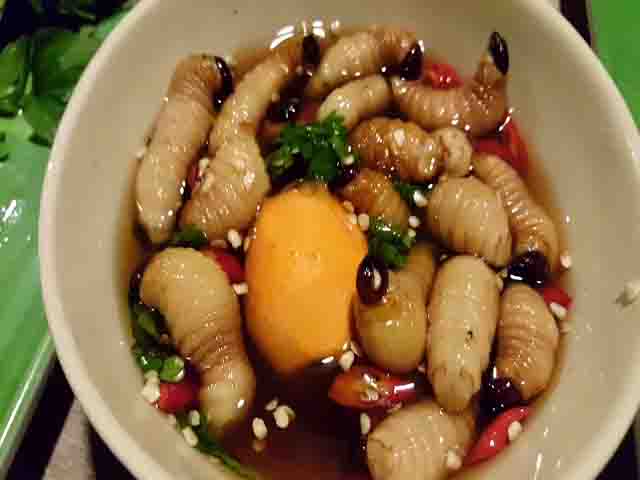
This is the specialty you can find only in Mekong Delta and not every tourist would willing to try this dish. To protect the biological environment, the mass consumption of Coconut Larvae is prohibited by local government. However, you still can try the dish cooked with Duong Dua if you really want. The most famous dish is raw coconut worms dipped in salty fish sauce. The young white milky coconut worms are kept alive, put in a bowl of fish sauce and eaten alive just like that.
Despite how frightening it looks, Duong Duong taste so good with the greasy, rich flavor just like an slowly dissolving an egg yolk.
Hu Tieu My Tho
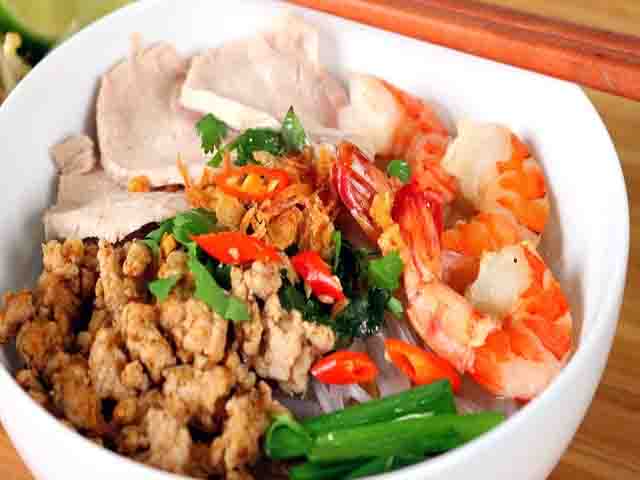
Originated from My Tho, Hu Tieu My Tho is a famous variation of Hu Tieu which is a very popular noodle soup in South Vietnam. The broth used in this soup is made from boiling pork bones and cooked with ground pork. The toppings are stir-fried ground pork, pig intestines, couple of prawns and finished with onions and bean sprouts. Come to My Tho to try this delicious bowl of noodle soup.
Bong Dien Dien (Dien Dien Flowers)

When the rainy season comes to Mekong Delta, it’s also the time for Dien Dien flowers bloom. The flower so familiar to Mekong Delta dwellers so that it appears on so many dishes from hotpot, salad to soup…
The flower buds have light yellow color, taste sweet with a pleasant fragrance when cooked. Bong Dien Dien is often used in fish hotpot to complete the dish’s taste as well as its appearance. The flowers are mostly grown by the locals but you still can find it in wet market.
Banh Pia (Pia Cake)

This is the most famous gift to bring back from Mekong Delta. Originated from Soc Trang, Pia Cake has conquered the whole country and even abroad with its addicting sweet taste and aromatic durian’s fragrance. The cake is creamy, nutritious and you can’t get enough of it after tasting the first time.
HOW TO GET TO MEKONG DELTA
To get to Mekong Delta, you can start at Ho Chi Minh city – the main gateway to the southern region of Vietnam as well as a worthy tourist destination. The most common route for most visitors to reach the destination is from Saigon to Can Tho which is 165 kilometers long.
By Bus:
Express Bus and Sleeper Bus are available with prices ranging from 60,000VND to 120,000VND. Buses depart many times a day, picking up passengers along the roads.
By Plane:
Or you can just book a flight to Can Tho which lasts only 45 minutes. Two airlines operate flights from Saigon to Can Tho: VASCO and VietJet Air. One-way ticket costs about 600,000VND.
From Saigon, you also can use another option: sailing your way Mekong Delta by booking a Mekong river cruise.
Hue to Hoi An by Jeeps has completed our travel guide to Mekong Delta Vietnam with all the highlighted things to do and see that can’t be missed in your trip. Mekong Delta is a large region with a lot of sites to check out and it’s understandable if you feel a bit overwhelmed. Why not let our travel consultant help arrange your trip to Mekong Delta by sending your request to chiduyencssh@gmail.com today? We cater not only Mekong Delta land tours from 4 days to 9 days but also Mekong cruises for 2 days and Mekong Delta tours combined with other offshore island Con Dao.

